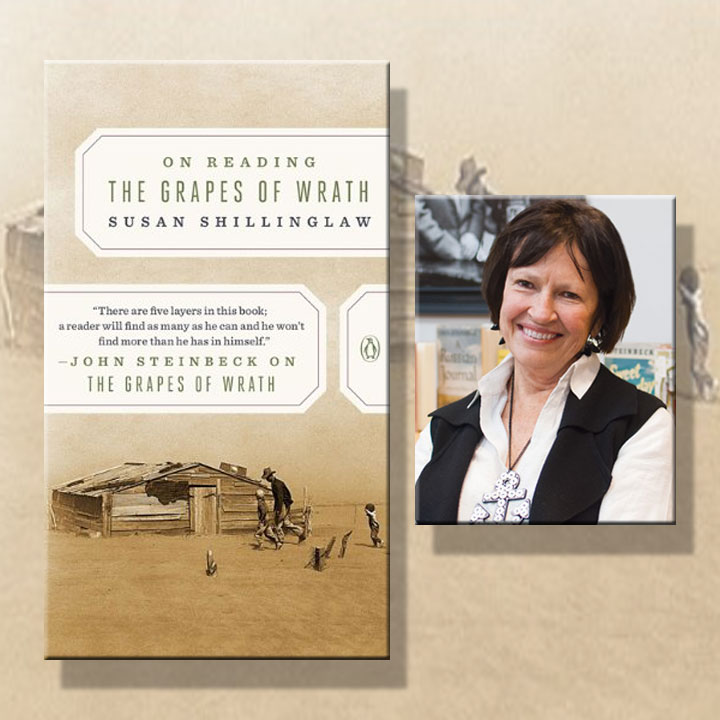 Great books about great books are cause for celebration anytime. Thanks to the pressure of a 75th anniversary deadline—and the prodding of the people at Penguin Books—John Steinbeck’s The Grapes of Wrath now has a perfect companion in On Reading “The Grapes of Wrath” by Susan Shillinglaw, professor of English at San Jose State University. Recently published by Penguin Books as an attractive, affordable paperback, her new book is an essential guide to a novel that was written in nine months in 1938 and still sells in six figures—further evidence, if needed, that deadlines are enlivening. A compact work of 200 pages divided into engaging topics, the project was suggested by Penguin Books and completed by Shillinglaw in 90 days. Written in clear prose for a general audience, it will still be read when The Grapes of Wrath turns 100.
Great books about great books are cause for celebration anytime. Thanks to the pressure of a 75th anniversary deadline—and the prodding of the people at Penguin Books—John Steinbeck’s The Grapes of Wrath now has a perfect companion in On Reading “The Grapes of Wrath” by Susan Shillinglaw, professor of English at San Jose State University. Recently published by Penguin Books as an attractive, affordable paperback, her new book is an essential guide to a novel that was written in nine months in 1938 and still sells in six figures—further evidence, if needed, that deadlines are enlivening. A compact work of 200 pages divided into engaging topics, the project was suggested by Penguin Books and completed by Shillinglaw in 90 days. Written in clear prose for a general audience, it will still be read when The Grapes of Wrath turns 100.
Susan Shillinglaw’s new book is an essential guide to a novel that was written in nine months in 1938 and still sells in six figures.
San Jose State University’s reputation for Steinbeck studies rests largely on Shillinglaw’s 25-year record of teaching, writing, and organizing around California’s greatest author of all time; in international Steinbeck circles, perhaps three other scholars in America come to mind as quickly as she does when Steinbeck studies are mentioned. The late Peter Lisca unlocked the structure of Steinbeck’s fiction using the tools of formal analysis. Jackson Benson, another Californian, wrote the definitive biography. Robert DeMott—the first director of San Jose State University’s center for Steinbeck studies—continues to explore the sources, texts, and processes of Steinbeck’s writing with the care of a scientist and the soul of a poet.
San Jose State University’s reputation for Steinbeck studies rests largely on Shillinglaw’s 25-year record.
Shillinglaw builds on all three in her new book, combining structural, biographical, and textual approaches with features that have become her signature as a writer about Steinbeck. As in her previous publications, she brings Steinbeck out of the past into the present, connecting the context, content, and impact of The Grapes of Wrath to urgent issues of contemporary life. As she has done in essays and conferences, she brings Steinbeck’s ecology into existential focus through the writer’s relationship with Ed Ricketts, connecting The Grapes of Wrath to Sea of Cortez, their collaborative work, in what she describes as a “diptych” of two books with one theme. Most important for most readers, she brings a graceful style of expression to an author who cared more about being read than being written about. In this she emulates her subject; On Reading “The Grapes of Wrath” is further evidence of the all-too-rare virtue of readability.
Shillinglaw brings a graceful style of expression to an author who cared more about being read than being written about.
For such a book the highest praise may be the briefest: On Reading “The Grapes of Wrath” is a one-volume course in John Steinbeck’s masterpiece, efficiently organized, elegantly presented, and easily assimilated in a matter of hours. Wherever you’re headed in this summer of Steinbeck, don’t leave home without it. (Future party alert! This advice will still apply when The Grapes of Wrath celebrates its centennial. Like Steinbeck’s fiction, Penguin Books and On Reading “The Grapes of Wrath” are certain to be around for a very long time.)


If it’s by Susan Shillinglaw, it will be very fine. Thanks for the piece, Will.
Take notes for me!
Will–Bravo to Susan, to Penguin, to SJSU for celebrating and illuminating Steinbeck and The Grapes of Wrath in such a moving and visible way. And to you for showcasing all worthy things Steinbeckian. We have needed this kind of web presence for a long time. Great to see Steinbeck getting his due. One correction: I was visiting director of the Steinbeck Center at SJSU in 1984 and 1985, but the Center was founded by –and is now named for–Martha Heasley Cox, its first director.
Thank you, Bob. Correction noted–with the additional observation that you prepared the way during your legendary time at SJSU by acquiring important items, including the author’s typewriter, for the collection now known as the Martha Heasley Cox Center for Steinbeck Studies. Does that make you, if not the Founder of the Church, perhaps John the Baptist?